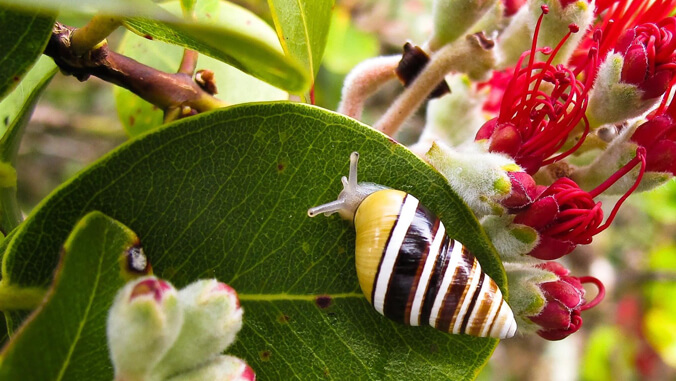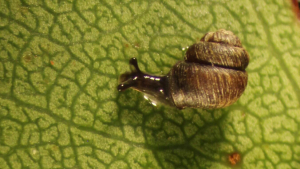
Hawaiian land snails, most of which are found nowhere else in the world, are among some of the most threatened animals on the planet. A collaboration between the University of Hawaiʻi at Mānoa, Bernice Pauahi Bishop Museum and the Hawaiʻi Department of Land and Natural Resources to conserve endangered Hawaiian land snails is one of six new projects funded by a partnership between the National Science Foundation (NSF) and the Paul G. Allen Family Foundation.
The three-year, $1,595,518 project will inform and identify capacity shortfalls to advance conservation science and action for endangered Hawaiian land snails. With nearly 60% of Hawaiian land snails already extinct, research to address immediate conservation action for the remaining few is urgently needed.

The research team, including Kiana Frank, assistant professor at the Pacific Biosciences Research Center (PBRC) in the UH Mānoa School of Ocean and Earth Science and Technology (SOEST), will identify host plant preferences, characterize feeding ecology and determine primary microbial food resources that are critical for enhancing captive rearing and wild propagation of endangered land snails in Hawaiʻi.
“This project is strongly aligned with values and mission of PBRC and C-MAIKI (Center for Microbiome Analysis through Island Knowledge & Investigation) as well as aligned to the strategic vision of the university by forwarding innovative and applicable work at the intersections of the environment and microbiome to support stewardship and sustainability of environmental resources,” said Frank, who is a co-investigator on the project.
Support from NSF and the Paul G. Allen Family Foundation will be used to address major knowledge gaps regarding endemic land snail feeding ecology. Specifically, the project will examine the microbial food resources found on native plants on which snails live and develop culturing methods to grow the preferred plants and microbial communities to improve the efficiency of captive rearing. Knowledge gained from this will have benefits for restoring native ecosystems into which captive-reared snails can be released, benefiting conservation for a diversity of Hawaiian organisms that rely on native ecosystems and the services they provide.
In collaboration with the team, Frank’s role on the project is threefold: as a researcher, to support the environmental microbiome component; as an educator, to support the next generation training program which will be run synergistically with her REU: Environmental Biology for Pacific Islanders; and as a science communicator, to bridge connections between Indigenous ways of knowing and western science in both practice and application to improve conservation outcomes.
“This award will allow our team to develop the foundation for transforming conservation of Hawaiian land snails in the coming decade, and provide deeper insights into how plants, snails and microbes interact in Hawaiʻi’s diverse native ecosystems,” said Kenneth Hayes, director of the Pacific Center for Molecular Biodiversity at Bishop Museum and lead investigator for the project.

